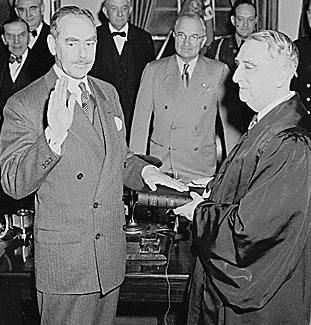 |
- one of the conservative establishment "wise men" - 1
- Europe-First, containment by arms and allies
1949/04/04 - NATO signed - a "vital" interest of the highest priority
- Senate debate April-July over $1b MAP
- Acheson promised no U.S. troops would be sent to Europe
1949/09/23 - Russia announced publicly its first successful test of the A-bomb (actually exploded July 14)
1949/10/01 - "fall" of China when Mao Zedong proclaimed the People's Republic of China.
- Acheson had recommended Feb. 3 that the U.S. "cut loose" from Chiang Kai-shek and stop a shipment of $60m in supplies, but Congress opposed and Truman approved the shipment.
- Acheson's State Dept. produced China "White Paper" in August 1949 that was a factual rebuttal of the China Lobby and congressional support for Chiang, with 645 pages of documents blaming China's problems on Chiang, not the communists.
1949/12/01 - Chiang Kai-shek moved to Formosa and created Nationalist government.
- new Secretary of Defense Louis Johnson wanted active U.S. defense of Formosa, but Acheson opposed.
1949/12/27 - Truman followed Acheson rather than Johnson, promised aid to Chiang but no military intervention.
1949/12/31 - NSC 48/2 defined SE Asia as a "major" interest, but only to support allies.
- U.S. should support French colonial government against Ho Chi Minh.
- also support for Brit. in Malaysia, for Philippines against Huks.
1950/01/12 - "perimeter" speech to National Press Club
- Japan, Okinawa, Philippines, Aleutians were inside the perimeter to be defended.
- Formosa and South Korea were outside the perimeter.
- Acheson followed Douglas MacArthur's statement March 1, 1949: "Our defensive dispositions against Asiatic aggression used to be based on the west coast of the American continent. The Pacific was looked upon as the avenue of possible enemy approach. Now the Pacific has become an Anglo-Saxon lake and our line of defense runs through the chain of islands fringing the coast of Asia. It starts from the Philippines and continues through the Ryukyu Archipelago, which includes its main bastion, Okinawa. Then it bends back through Japan and the Aleutian Island chain to Alaska."
- Acheson concluded "American Assistance can be effective when it is the missing component in a situation which might otherwise be solved. The U.S. cannot furnish determination, the will, the loyalty of a people to its government."
1950/01/30 - Truman approved H-bomb development, and ordered a re-evaluation of American policy that resulted in NSC-68 by April 12; Paul Nitze replaced George Kennan in PPC.
1950/02/09 - Joseph McCarthy speech at Wheeling said 57 communists in State Dept. (later 205, then 81)
1950/02/14 - Sino-Soviet 30-year alliance treaty signed after Mao's 2-month visit with Stalin in Moscow Dec. '49 - Jan. '50.
1950/03/01 - Klaus Fuchs arrested in Britain for atomic spying.
1950/04/12 - Truman approved NSC-68.
- key idea of "coercion" - must spend 20% of GNP on defense ($50b) - expand U.S. military forces into Europe, tighten western alliance and integrate military planning, assume indefinite period of danger from the "ruthless fanatics" spreading monolithic global communism; engage in "total diplomacy" from all agencies of government (Acheson speech to AdCo Feb. 16); develop public support at home for the long struggle
- conclusion - " the cold war is in fact a real war in which the survival of the free world is at stake"
- Ted Turner documentary Are We Winning, Mommy?
1950/04/20 - Truman called for "Campaign of Truth" to puncture the Russian "Big Lie"
- Freedom Train; Voice of America and Radio Free Europe; Munich transmitter Project Dumbo; relay bases at Manila and Honolulu and Salonika and Tangier; Project Troy at MIT to develop megawatt transmitters to overcome jamming and beam radio into Russia; the "Ring Plan" was funded Sept. 27 by Congress with $41m appropriation, raised to $61m in 1951 to build 6 megawatt transmitters in the U.S., also raised was the budget of U.S. International Information and Education Exchange Program (USIE) to $131m by 1951.
Sources:
- MacArthur's statement is from Dean Acheson. Present at the Creation: My Years at the State Department. New York: Norton, 1969, pp. 355-358.
- Age of Paranoia and Cold War Spies and NSA and USIA